
A. D. Coleman as Hillary Clinton, selfie, 7-24-16
Don and The Deplorables
No, that’s not a new garage band.
Just when I found myself on the verge of complaining that, from the standpoint of visual imagery and photographic evidence, this post-convention election cycle has come up short, Hillary Clinton starred inadvertently in back-to-back video clips that immediately went viral and could prove damaging to her campaign.
On the evening of September 9, with the press in attendance and the tv cameras on, she told an audience of donors at a fund-raiser in New York that half of Donald Trump’s supporters fall into what she termed “the basket of deplorables,” defining that as people who are racist, sexist, homophobic, xenophobic, Islamophobic, or some combination of the above. While demonstrably true — indeed, many of Trump’s devotees take pride in those qualities — Clinton herself saying so strikes me as impolitic, imprudent, and unnecessary.
Though the press has allowed Trump to lie continuously with relative impunity, Trump’s supporters aren’t shy about flying their true colors, which has received extensive coverage. Be that as it may, sage counsel would have Clinton staying above that fray unless and until the vituperation comes directly at her and directly from Trump himself.
To be fair, Clinton followed that flippant if accurate dismissal with a sympathetic portrayal of the other half of Trump’s base. So I don’t think this will turn into Clinton’s “47 percent” moment. But that comment didn’t do her any good with the 10 percent of undecided voters she needs to sway in her direction over the next two months, including fence-sitting moderate Republicans. She’s running against Trump, not those ready to vote for him or still thinking it over, and she needs to keep that clearly in mind.

Hillary Clinton stumbles, NYC, 9-11-16, Twitter
Then, a day and half later, she had a fainting spell at the 9/11 memorial ceremony in lower Manhattan, unfortunately caught on cellphone video by a Czech attendee, Zdenek Gazda. Spokespersons initially described it as the result of Clinton becoming “overheated,” but later that day the candidate authorized her doctor to acknowledge that Clinton presently suffers from what some call walking pneumonia (though apparently not its frequent companion, the boogie-woogie flu).
All of which sent the talking heads, the tabloid press, and social media into a tizzy. Not to mention the wingnut right, whose paranoid conspiracy theories re Clinton’s supposedly failing health found ample fuel in this minor moment. Briefly, it looked as if Clinton had hit a major bump in the road.
The Beginning of the End
Then, on Monday night, came the first debate, which, in my humble opinion, not only changed the game but decided it.
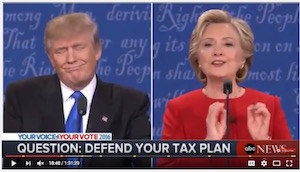
Clinton-Trump debate, 9-26-16, screenshot (a)
As I understand the statistical analysis of this and other presidential elections, by midsummer 90 percent of the voting public had already made up its mind (barring some dramatic revelation). And, historically, most registered voters endorse the party line. So if, going into the first debate, Trump and Clinton effectively ran neck and neck, they each needed to sway a majority of those still undecided. The experts suggest that, this time around, it means suburban soccer moms (for which read: white, college-educated, middle-class), who need to decide which of the two candidates will keep them and their families safe.
Though I’m undeniably Caucasian, and like to think of myself as reasonably in touch with my feminine aspect, I can’t come closer than that to the mindset of the suburban mom. Still, to the extent that my imagination allowed, I tried to watch the debate through that lens. Indeed, I did so twice.
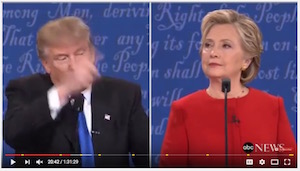
Clinton-Trump debate, 9-26-16, screenshot (b)
For the first run-through, I watched it live on CBS, with the sound on — to share the real-time experience of the estimated 84 million viewers nationally and 110 million worldwide. Jeff Yang at CNN summed up my response well:
Faced with a single rival with clearly distinct ideas and experience and a staunchly unflappable attitude, [Trump] seemed rude, ignorant, volatile and churlish. Despite pundit assertions that Hillary Clinton had the burden of proof in this debate, the truth is that she simply needed to hold strong and let Hurricane Trump blow itself out. And she did.
The second time around, I watched it (by necessity) canned, on ABC (via YouTube) with the sound off — following the sage advice of James Fallows in a detailed pre-debate analysis for The Atlantic:
The rule is that the way candidates react, immediately and usually involuntarily, while caught by the camera, dominates impressions of who has “won” or “lost” an encounter. This is why the most accurate way to predict reaction to a debate is to watch it with the sound turned off.
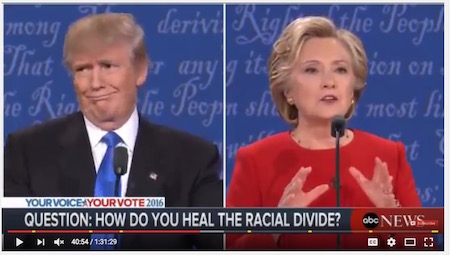
Clinton-Trump debate, 9-26-16, screenshot (c)
My overriding response to my first (audio-video) exposure: The Donald Trump you see is the Donald Trump you get. Always. There is no other Donald Trump — no kinder, gentler, more articulate, better-informed, statesmanlike version of The Donald, one capable of diplomacy, nuanced argument, and course correction. Just a man so ego-ridden that — especially if challenged — he feels compelled to double down on every idiotic thing he’s ever said and every lie he’s ever told, even when his shot at the presidency hangs in the balance.
Trump has difficulty completing his sentences, speaking often in sentence fragments, digressing, bouncing from topic to topic. To see what his spoken English would like transformed into college-level English 101 prose, go to “Copy-Editing Trump: The First-Presidential-Debate Edition” by Andrew Boynton. Boynton, a professional copy editor at The New Yorker, took the time to go through a transcript of Trump’s remarks from this first debate and convert passages of it into basic grammatically correct language, which you can view here complete with his editing notes.
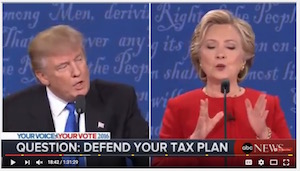
Clinton-Trump debate, 9-26-16, screenshot (d)
In terms of rhetorical style, Trump alternates between haranguing, accusing, berating, insulting, mansplaining … and manterrupting. Trump interrupted Clinton 51 times, 25 times in the first 26 minutes. (Almost as many times as he sniffled, this mannerism becoming the night’s first meme.) He interrupted moderator Lester Holt four times. Time.com offers a fine interactive infographic that enables you to see the pattern of interruptions (including Clinton’s) and click on each one to reach the moment in the transcript at which it occurred. That doesn’t include the many times he interrupted himself, stopping in mid-sentence to veer off on some tangent.
•
Unlike Jonathan Mahler, who got paid by the New York Times to watch the show with the sound muted, I did it uncompensated, just to see what I could learn. I wouldn’t recommend it to you, but it did have its revelations. For one, I saw a man simply incapable of stillness. Whether this results from impatience, ADHD, or some other cause, The Donald is, somewhere in his face and body, almost always in motion. For all his overt self-assurance, when compared to Clinton with her ability to maintain a composed visage and quiet body, Trump comes across as agitated and uncomfortable in his own skin.
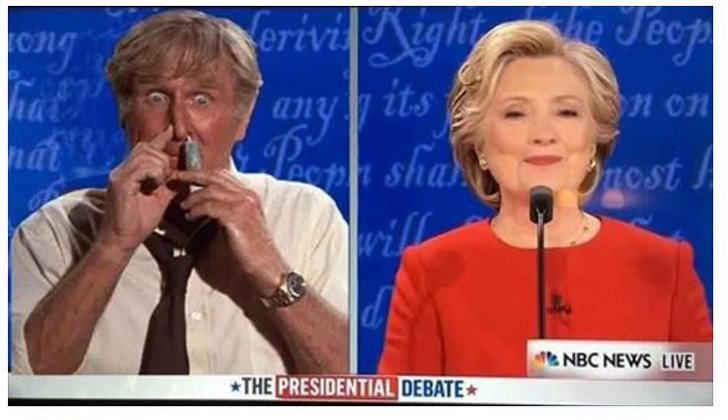
Clinton-Trump debate, 9-26-16, anonymous meme
The second is that he appears unable to tolerate having the attention of the audience directed elsewhere than at him for a full minute: once you hit the 45-second mark he’s either going through his repertoire of exaggerated facial expressions, moving his body, adjusting his mic, taking a sip of water, or interrupting — unless he’s the one talking.
Third, I finally identified something about Trump’s body and body language that I haven’t managed to pin down until now: For those of a big man, his gestures seem not merely less than expansive but unusually cramped and constrained, commonly performed with his arms held close to his sides. This gives him a marionette-like manner, making the idiosyncratic positions in which he holds his little hands and fingers look all the more odd.
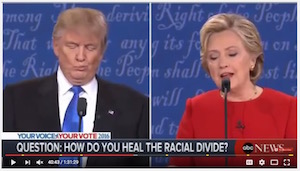
Clinton-Trump debate, 9-26-16, screenshot (e)
Fourth, The Donald, when talking, directs his comments most consistently to the moderator, Lester Holt, and after that to Clinton; when not talking, he looks almost anywhere but at the audience or the camera, often closing his eyes. Clinton consistently makes prolonged eye contact with the audience and viewer, both when speaking and when listening. When not speaking herself, Clinton pays Trump the basic respect of turning her head toward him and looking directly and calmly at him as he fulminates. Trump, by contrast, seems incapable of looking at Clinton for more than a few seconds as she speaks. I found myself reminded of John McCain’s visceral unwillingness to look at Barack Obama during their debates.
•

Clinton-Trump debate, 9-26-16, anonymous meme (b)
The administration of Hofstra University (which hosted this event) and moderator Holt had enjoined the audience — composed mostly of students — from cheering, applauding, or otherwise voicing opinions during the debate. The attendees violated that rule a number of times, but for the most part the nominees delivered their comments to a silent room. Trump thrives on immediate feedback; indeed, without it his off-the-cuff approach to public speaking falls flat. By the time the first half-hour had passed, he had run out of energy.
Nearing the end, there’s a potent, revealing moment, starting at timestamp 1:09:08. Holt asks Trump about his approval of the invasion of Iraq in 2002 — a matter of historical fact. Trump launches into a hopelessly convoluted denial of that position, claiming that Sean Hannity can back up his assertion that (albeit privately) he opposed the invasion from the beginning. It ends with a boast about his judgment and temperament. Clinton wisely lets him dig this hole as deeply as he cares to, but you can see her mounting delight as she realizes the debate has ended and she has won.
When Trump finally shuts up, almost three minutes later, Clinton does a happy dance. It’s just a little quiver of her shoulders (at timestamp 1:11:57), but it speaks volumes, and immediately became a meme.
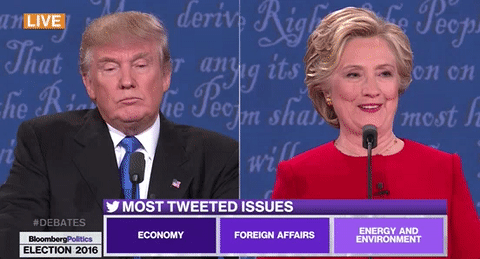
Hillary Clinton shoulder shimmy, first debate with Donald Trump, 9-26-16
By the end, having consistently risen to the bait tossed out by Clinton, Trump declares that Clinton “doesn’t have the look, doesn’t have the stamina” for the office of president. And that’s when she sticks the fork in and turns him over, setting him off on a tirade about Rosie O’Donnell and opening up the saga of Trump’s humiliation of former Miss Universe Alicia Machado — on which, true to form, The Donald would double down the next morning.
So, from a strictly visual standpoint, the enduring images of the first Clinton-Trump debate: a confident, satisfied, beaming Clinton and a sneering, scowling, unhappy Trump. Small wonder, for anyone who absorbed the debate’s verbal content. In 90 minutes, Trump managed to alienate any undecided African Americans, Latinos, and women whom he might have swayed to his side. Lacking any appeal to the Bernie Bros and other millennials still considering a mainstream candidate, that leaves voter intimidation and suppression as his Hail Mary pass.
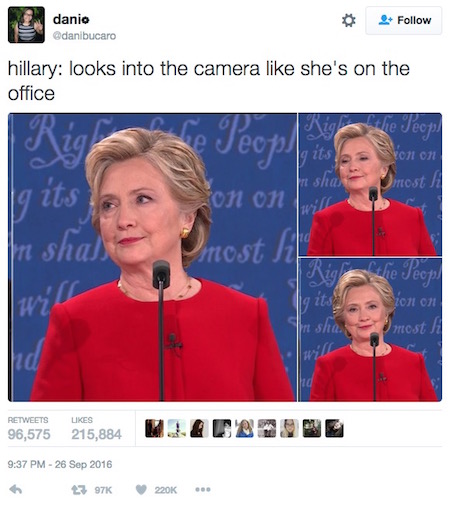
Clinton-Trump debate, 9-26-16, Twitter response
The Kids Aren’t Alright
Not to let Daddy outdo them in the gauche department, Donald Trump Jr. not only managed to say something in an interview that sounded suspiciously like a Holocaust reference but tweeted out a campaign ad for The Donald featuring a photo of himself and his siblings …

Trump siblings, Twitter, 9-2-16
… that instantly got social media buzzing with comparisons to Children of the Corn and other horror films featuring young protagonists:
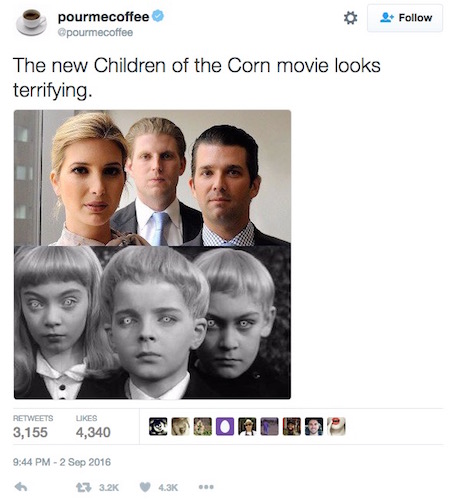
Trump siblings, “Children of the Corn,” Twitter, 9-2-16
After which, to prove that he has inherited his daddy’s social-media skills, he generated the indelible visual comparison of Syrian refugees to Skittles:
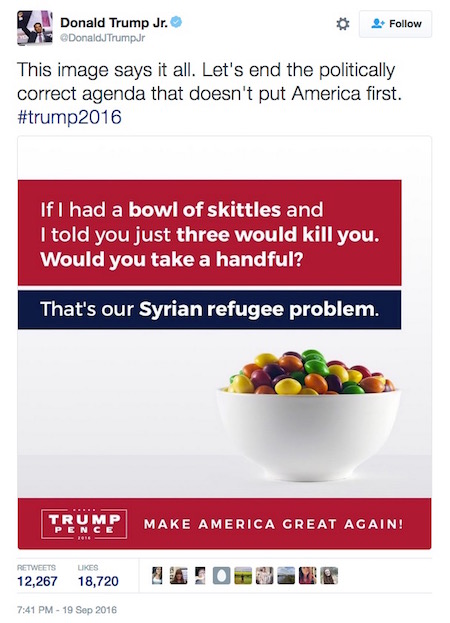
Donald Trump, Jr, Skittles tweet, 9-19-16
Not to mention that the photograph of said candy that he snagged off Flickr for his purposes was made by David Kittos, 48, “who said he lives in the United Kingdom and left Cyprus as a refugee when he was 6, [and] claims that he was not asked permission for use of his photo.” (See Catherine Thorbecke’s September 20, 2016 report for ABC News.) Kittos also said “I’m really really appalled by having my image, you know, on Twitter used against the refugees.”
And Skittles itself (themselves?) definitely took the high road when this erupted.
Bring On Those Tacos
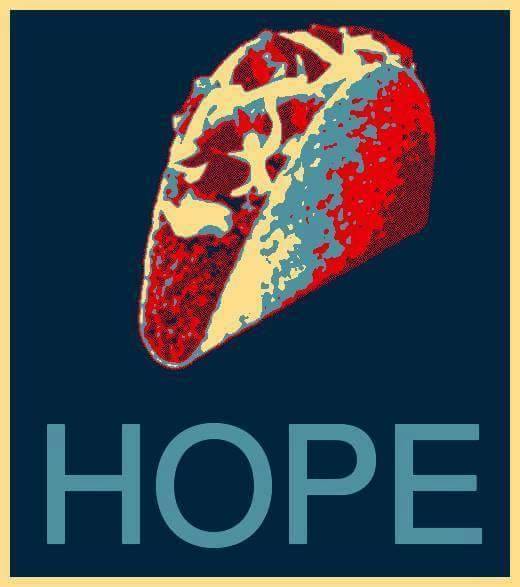 It would not have occurred to me that — beyond Drumpf’s enjoyment of taco bowls and love for all Hispanics — Mexican fast food would play an imagistic role in this election. Color my face rojo.
It would not have occurred to me that — beyond Drumpf’s enjoyment of taco bowls and love for all Hispanics — Mexican fast food would play an imagistic role in this election. Color my face rojo.
Enter the meme of tacos … specifically, the viral result of a threat that, if The Donald doesn’t win this election, Mexicans will swarm the U.S. to such an extent that we’ll end up with access to tasty, freshly prepared, inexpensive Mexican food everywhere.
This dire warning came from an apparent scam artist named Marco Gutierrez, scion of illegal Mexican immigrants and an immigrant himself. Gutierrez, like his idol a man with a long track record of scams and collapsed real-estate deals, had his California real-estate broker’s license revoked. (In the interview, he insists that “I did not lose my real-estate license; I surrendered it.”) According to Slate, he and his wife have filed for bankruptcy 14 times. After which, casting about for a new venture, he founded an organization called Latinos for Trump.
 You can find out more in Samantha Bee’s gem-like take down of this man, who, a true credit to his people, tells MSNBC at the top of the Full Frontal segment that “My culture is a very dominant culture. It’s imposing, and it’s causing problems. If you don’t do something about it, you are going to have taco trucks on every corner.” I can’t help suspecting that he has a substantial investment in the taco-truck business.
You can find out more in Samantha Bee’s gem-like take down of this man, who, a true credit to his people, tells MSNBC at the top of the Full Frontal segment that “My culture is a very dominant culture. It’s imposing, and it’s causing problems. If you don’t do something about it, you are going to have taco trucks on every corner.” I can’t help suspecting that he has a substantial investment in the taco-truck business.
A bit later, Guiterrez informs Bee’s correspondent, Mike Rubens, that “As Hispanics, we are a primitive and underdeveloped culture. We’ll take whatever we can take.” Still, speaking as a long-time resident of a community that includes many Hispanics but not a single taco truck, I say this: If it takes electing Hillary Clinton to get a taco truck on even one corner of my neighborhood, I’m with her.
Read Their Lips (Wrongly)
For more leavening humor, I strongly recommend “DEMOCRATIC NATIONAL CONVENTION” — A Bad Lip Reading.” Think of this as reverse lip-synching, whereby someone not particularly skilled at lip-reading gives voice to what Bernie Sanders, Hillary and Bill and Chelsea Clinton, Barack Obama, and several others appear to have said at the DNC.
•
(For an index of links to all posts in this series, click here.)
•
 Special offer: If you want me to either continue pursuing a particular subject or give you a break and (for one post) write on a topic — my choice — other than the current main story, make a donation of $50 via the PayPal widget below, indicating your preference in a note accompanying your donation. I’ll credit you as that new post’s sponsor, and link to a website of your choosing. Include a note with your snail-mail address (or email it to me separately) for a free signed copy of my 1995 book Critical Focus!
Special offer: If you want me to either continue pursuing a particular subject or give you a break and (for one post) write on a topic — my choice — other than the current main story, make a donation of $50 via the PayPal widget below, indicating your preference in a note accompanying your donation. I’ll credit you as that new post’s sponsor, and link to a website of your choosing. Include a note with your snail-mail address (or email it to me separately) for a free signed copy of my 1995 book Critical Focus!
Election 2016: Image World (14)
A. D. Coleman as Hillary Clinton, selfie, 7-24-16
Don and The Deplorables
No, that’s not a new garage band.
Just when I found myself on the verge of complaining that, from the standpoint of visual imagery and photographic evidence, this post-convention election cycle has come up short, Hillary Clinton starred inadvertently in back-to-back video clips that immediately went viral and could prove damaging to her campaign.
On the evening of September 9, with the press in attendance and the tv cameras on, she told an audience of donors at a fund-raiser in New York that half of Donald Trump’s supporters fall into what she termed “the basket of deplorables,” defining that as people who are racist, sexist, homophobic, xenophobic, Islamophobic, or some combination of the above. While demonstrably true — indeed, many of Trump’s devotees take pride in those qualities — Clinton herself saying so strikes me as impolitic, imprudent, and unnecessary.
Though the press has allowed Trump to lie continuously with relative impunity, Trump’s supporters aren’t shy about flying their true colors, which has received extensive coverage. Be that as it may, sage counsel would have Clinton staying above that fray unless and until the vituperation comes directly at her and directly from Trump himself.
To be fair, Clinton followed that flippant if accurate dismissal with a sympathetic portrayal of the other half of Trump’s base. So I don’t think this will turn into Clinton’s “47 percent” moment. But that comment didn’t do her any good with the 10 percent of undecided voters she needs to sway in her direction over the next two months, including fence-sitting moderate Republicans. She’s running against Trump, not those ready to vote for him or still thinking it over, and she needs to keep that clearly in mind.
Hillary Clinton stumbles, NYC, 9-11-16, Twitter
Then, a day and half later, she had a fainting spell at the 9/11 memorial ceremony in lower Manhattan, unfortunately caught on cellphone video by a Czech attendee, Zdenek Gazda. Spokespersons initially described it as the result of Clinton becoming “overheated,” but later that day the candidate authorized her doctor to acknowledge that Clinton presently suffers from what some call walking pneumonia (though apparently not its frequent companion, the boogie-woogie flu).
All of which sent the talking heads, the tabloid press, and social media into a tizzy. Not to mention the wingnut right, whose paranoid conspiracy theories re Clinton’s supposedly failing health found ample fuel in this minor moment. Briefly, it looked as if Clinton had hit a major bump in the road.
The Beginning of the End
Then, on Monday night, came the first debate, which, in my humble opinion, not only changed the game but decided it.
Clinton-Trump debate, 9-26-16, screenshot (a)
As I understand the statistical analysis of this and other presidential elections, by midsummer 90 percent of the voting public had already made up its mind (barring some dramatic revelation). And, historically, most registered voters endorse the party line. So if, going into the first debate, Trump and Clinton effectively ran neck and neck, they each needed to sway a majority of those still undecided. The experts suggest that, this time around, it means suburban soccer moms (for which read: white, college-educated, middle-class), who need to decide which of the two candidates will keep them and their families safe.
Though I’m undeniably Caucasian, and like to think of myself as reasonably in touch with my feminine aspect, I can’t come closer than that to the mindset of the suburban mom. Still, to the extent that my imagination allowed, I tried to watch the debate through that lens. Indeed, I did so twice.
Clinton-Trump debate, 9-26-16, screenshot (b)
For the first run-through, I watched it live on CBS, with the sound on — to share the real-time experience of the estimated 84 million viewers nationally and 110 million worldwide. Jeff Yang at CNN summed up my response well:
Faced with a single rival with clearly distinct ideas and experience and a staunchly unflappable attitude, [Trump] seemed rude, ignorant, volatile and churlish. Despite pundit assertions that Hillary Clinton had the burden of proof in this debate, the truth is that she simply needed to hold strong and let Hurricane Trump blow itself out. And she did.
The second time around, I watched it (by necessity) canned, on ABC (via YouTube) with the sound off — following the sage advice of James Fallows in a detailed pre-debate analysis for The Atlantic:
The rule is that the way candidates react, immediately and usually involuntarily, while caught by the camera, dominates impressions of who has “won” or “lost” an encounter. This is why the most accurate way to predict reaction to a debate is to watch it with the sound turned off.
Clinton-Trump debate, 9-26-16, screenshot (c)
My overriding response to my first (audio-video) exposure: The Donald Trump you see is the Donald Trump you get. Always. There is no other Donald Trump — no kinder, gentler, more articulate, better-informed, statesmanlike version of The Donald, one capable of diplomacy, nuanced argument, and course correction. Just a man so ego-ridden that — especially if challenged — he feels compelled to double down on every idiotic thing he’s ever said and every lie he’s ever told, even when his shot at the presidency hangs in the balance.
Trump has difficulty completing his sentences, speaking often in sentence fragments, digressing, bouncing from topic to topic. To see what his spoken English would like transformed into college-level English 101 prose, go to “Copy-Editing Trump: The First-Presidential-Debate Edition” by Andrew Boynton. Boynton, a professional copy editor at The New Yorker, took the time to go through a transcript of Trump’s remarks from this first debate and convert passages of it into basic grammatically correct language, which you can view here complete with his editing notes.
Clinton-Trump debate, 9-26-16, screenshot (d)
In terms of rhetorical style, Trump alternates between haranguing, accusing, berating, insulting, mansplaining … and manterrupting. Trump interrupted Clinton 51 times, 25 times in the first 26 minutes. (Almost as many times as he sniffled, this mannerism becoming the night’s first meme.) He interrupted moderator Lester Holt four times. Time.com offers a fine interactive infographic that enables you to see the pattern of interruptions (including Clinton’s) and click on each one to reach the moment in the transcript at which it occurred. That doesn’t include the many times he interrupted himself, stopping in mid-sentence to veer off on some tangent.
•
Unlike Jonathan Mahler, who got paid by the New York Times to watch the show with the sound muted, I did it uncompensated, just to see what I could learn. I wouldn’t recommend it to you, but it did have its revelations. For one, I saw a man simply incapable of stillness. Whether this results from impatience, ADHD, or some other cause, The Donald is, somewhere in his face and body, almost always in motion. For all his overt self-assurance, when compared to Clinton with her ability to maintain a composed visage and quiet body, Trump comes across as agitated and uncomfortable in his own skin.
Clinton-Trump debate, 9-26-16, anonymous meme
The second is that he appears unable to tolerate having the attention of the audience directed elsewhere than at him for a full minute: once you hit the 45-second mark he’s either going through his repertoire of exaggerated facial expressions, moving his body, adjusting his mic, taking a sip of water, or interrupting — unless he’s the one talking.
Third, I finally identified something about Trump’s body and body language that I haven’t managed to pin down until now: For those of a big man, his gestures seem not merely less than expansive but unusually cramped and constrained, commonly performed with his arms held close to his sides. This gives him a marionette-like manner, making the idiosyncratic positions in which he holds his little hands and fingers look all the more odd.
Clinton-Trump debate, 9-26-16, screenshot (e)
Fourth, The Donald, when talking, directs his comments most consistently to the moderator, Lester Holt, and after that to Clinton; when not talking, he looks almost anywhere but at the audience or the camera, often closing his eyes. Clinton consistently makes prolonged eye contact with the audience and viewer, both when speaking and when listening. When not speaking herself, Clinton pays Trump the basic respect of turning her head toward him and looking directly and calmly at him as he fulminates. Trump, by contrast, seems incapable of looking at Clinton for more than a few seconds as she speaks. I found myself reminded of John McCain’s visceral unwillingness to look at Barack Obama during their debates.
•
Clinton-Trump debate, 9-26-16, anonymous meme (b)
The administration of Hofstra University (which hosted this event) and moderator Holt had enjoined the audience — composed mostly of students — from cheering, applauding, or otherwise voicing opinions during the debate. The attendees violated that rule a number of times, but for the most part the nominees delivered their comments to a silent room. Trump thrives on immediate feedback; indeed, without it his off-the-cuff approach to public speaking falls flat. By the time the first half-hour had passed, he had run out of energy.
Nearing the end, there’s a potent, revealing moment, starting at timestamp 1:09:08. Holt asks Trump about his approval of the invasion of Iraq in 2002 — a matter of historical fact. Trump launches into a hopelessly convoluted denial of that position, claiming that Sean Hannity can back up his assertion that (albeit privately) he opposed the invasion from the beginning. It ends with a boast about his judgment and temperament. Clinton wisely lets him dig this hole as deeply as he cares to, but you can see her mounting delight as she realizes the debate has ended and she has won.
When Trump finally shuts up, almost three minutes later, Clinton does a happy dance. It’s just a little quiver of her shoulders (at timestamp 1:11:57), but it speaks volumes, and immediately became a meme.
Hillary Clinton shoulder shimmy, first debate with Donald Trump, 9-26-16
By the end, having consistently risen to the bait tossed out by Clinton, Trump declares that Clinton “doesn’t have the look, doesn’t have the stamina” for the office of president. And that’s when she sticks the fork in and turns him over, setting him off on a tirade about Rosie O’Donnell and opening up the saga of Trump’s humiliation of former Miss Universe Alicia Machado — on which, true to form, The Donald would double down the next morning.
So, from a strictly visual standpoint, the enduring images of the first Clinton-Trump debate: a confident, satisfied, beaming Clinton and a sneering, scowling, unhappy Trump. Small wonder, for anyone who absorbed the debate’s verbal content. In 90 minutes, Trump managed to alienate any undecided African Americans, Latinos, and women whom he might have swayed to his side. Lacking any appeal to the Bernie Bros and other millennials still considering a mainstream candidate, that leaves voter intimidation and suppression as his Hail Mary pass.
Clinton-Trump debate, 9-26-16, Twitter response
The Kids Aren’t Alright
Not to let Daddy outdo them in the gauche department, Donald Trump Jr. not only managed to say something in an interview that sounded suspiciously like a Holocaust reference but tweeted out a campaign ad for The Donald featuring a photo of himself and his siblings …
Trump siblings, Twitter, 9-2-16
… that instantly got social media buzzing with comparisons to Children of the Corn and other horror films featuring young protagonists:
Trump siblings, “Children of the Corn,” Twitter, 9-2-16
After which, to prove that he has inherited his daddy’s social-media skills, he generated the indelible visual comparison of Syrian refugees to Skittles:
Donald Trump, Jr, Skittles tweet, 9-19-16
Not to mention that the photograph of said candy that he snagged off Flickr for his purposes was made by David Kittos, 48, “who said he lives in the United Kingdom and left Cyprus as a refugee when he was 6, [and] claims that he was not asked permission for use of his photo.” (See Catherine Thorbecke’s September 20, 2016 report for ABC News.) Kittos also said “I’m really really appalled by having my image, you know, on Twitter used against the refugees.”
And Skittles itself (themselves?) definitely took the high road when this erupted.
Bring On Those Tacos
Enter the meme of tacos … specifically, the viral result of a threat that, if The Donald doesn’t win this election, Mexicans will swarm the U.S. to such an extent that we’ll end up with access to tasty, freshly prepared, inexpensive Mexican food everywhere.
This dire warning came from an apparent scam artist named Marco Gutierrez, scion of illegal Mexican immigrants and an immigrant himself. Gutierrez, like his idol a man with a long track record of scams and collapsed real-estate deals, had his California real-estate broker’s license revoked. (In the interview, he insists that “I did not lose my real-estate license; I surrendered it.”) According to Slate, he and his wife have filed for bankruptcy 14 times. After which, casting about for a new venture, he founded an organization called Latinos for Trump.
A bit later, Guiterrez informs Bee’s correspondent, Mike Rubens, that “As Hispanics, we are a primitive and underdeveloped culture. We’ll take whatever we can take.” Still, speaking as a long-time resident of a community that includes many Hispanics but not a single taco truck, I say this: If it takes electing Hillary Clinton to get a taco truck on even one corner of my neighborhood, I’m with her.
Read Their Lips (Wrongly)
For more leavening humor, I strongly recommend “DEMOCRATIC NATIONAL CONVENTION” — A Bad Lip Reading.” Think of this as reverse lip-synching, whereby someone not particularly skilled at lip-reading gives voice to what Bernie Sanders, Hillary and Bill and Chelsea Clinton, Barack Obama, and several others appear to have said at the DNC.
•
(For an index of links to all posts in this series, click here.)
•